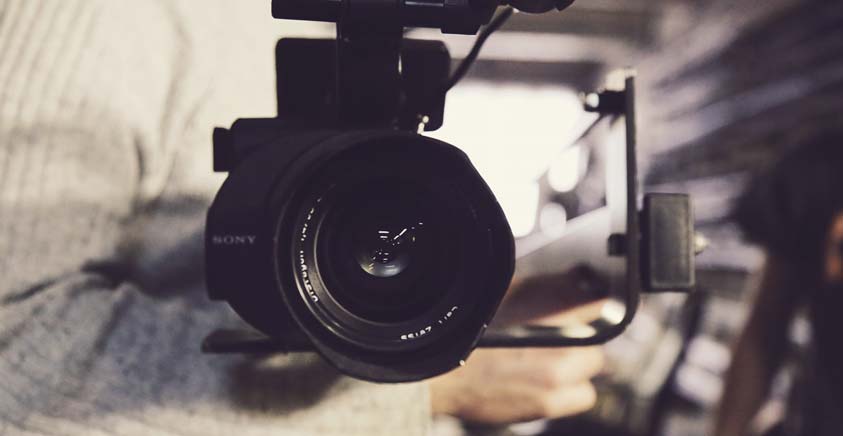Simply use source videos created at parties, holidays or family events to make a movie that enables you to relive these unique moments over and over again. No matter if it's a 360 degree film or an action movie, follow our tips and you'll soon be creating your own HD video masterpieces - with little effort and lots of fun!
Tell your story
Your movie should tell a captivating and compelling story. Naturally, this always depends on the specific subject matter and the style you're seeking to achieve with your video. There are two options to ensure that your movie has a common thread running through it:
- Either think about what your movie should look like beforehand, for example by writing a script beforehand (or at least have a mental picture of the narrative that you want your movie to convey).
- Or you could take a look at prerecorded material, such as movies of your grandchildren, and consider how you could create a story with a narrative of its own. In both cases, it makes sense to create some notes before editing your footage.
The following questions will help you to make your own video so that it is just as compelling for other people as it is for you:
- How should the movie be structured to ensure that the story you want to tell makes a big impression on the viewer?
- In which order should individual scenes be shown? Do you need to use flashbacks to tell your tale?
- Will the sound from the original video recordings always be used, or should the film be supported with appropriate music from time to time? Should any voiceover be edited in at a later date?
By thinking these questions through, you can save lots of time while movie making.
Filmmaking -
what you need to consider when filming

Camera settings for filmmaking
No matter whether you're a movie enthusiast or a pro, your aim when shooting a movie is to achieve a high-quality result. In this case, pay attention to the following: wide-angled shots capture a lot of detail at once, but viewers find it difficult to take everything in at a glance. This can be avoided by zooming in on the subject of your shot.
To ensure that all content that you want to show is still displayed, it is recommended to use several close-up shots in succession. Try to keep the camera steady on the subject of your shot, avoiding panning and zooming. Small wobbles can be corrected using image stabilization, which is supported by Movie Studio. Another factor to consider is the length of your scenes - and indeed, the length of the entire movie, so that your viewers' attention is retained throughout. Generally, shorter scenes are better than longer ones.
Once the key content has been shown, you can switch to the next scene. As you can reduce the length of each scene in post-production by using a video editing program, it is advisable to leave scenes longer to start with. You can then select the best editing for your video afterward. There are a lot of different techniques, you could try and you can improve for yourself and your project.
Perfect lighting and sound levels while filmmaking
Bright light makes your videos look good, while darkness is usually too great a challenge for most standard video cameras to cope with. To achieve a high-quality recording, ensure that good lighting is available. Daylight is best for this. As this cannot always be guaranteed indoors, video lighting is highly recommended. Lighting can be bought from big box electrical retailers or specialist stores at affordable prices.
The sounds levels are just as important as the lighting levels. Sounds is an important component of your movie and makes a major contribution to its quality. Audible interference should be avoided, especially in scenes where there is dialog. Outdoor shots, such as those near streets or the sea, entail a risk that the speaker may not be understood.
If, however, it is important to capture voice recordings even in stormy conditions, you should use a good microphone or add the audio track later when you make a video. Movie Studio by MAGIX allows you to start a voiceover with a single click and add it to any scene you wish. Sound from the camera can be muted, or the volume can simply be reduced. In Movie Studio Platinum you have the option of removing any audible interference or variations in volume altogether, enabling you to optimize your video through detailed audio editing.
Adding a certain something through fades, effects, and more.
When making a movie, you can use post-production to add classic video effects or special effects. From intro and outro animations through to transitions and artistic video effects, you can use video editing software to give your creativity free rein.
Movie Studio offers a wide range of possibilities for creating truly special movies! By using a template for intro animations, your video can enjoy a professional look from the outset. Fascinating transitions between individual scenes or extracts from your video can be achieved with a wide variety of fades. With everything from 3D transitions through to flower showers, you can make your dreams come to life. Effects such as reflections or camera transitions can give your video an artistic touch. Finally, you can end your movies with an outro animation that matches your intro.
You can use the software to find a design to suit any occasion, giving your movie the qualities of a box-office hit! As an aside, you can also use Movie Studio to create stop-motion videos.
Adding text
Not everyone likes hearing their own voice on a video. However, a vocal track can be disruptive in some circumstances. In this case, you can very easily create a text overlay instead.
Select a typeface and a color, position your text, and select how long it should be displayed for. When selecting a color, choose a shade that stands out from the background and that remains readable wherever possible. In addition, the text should never cover any relevant content in the video. Break the text down into different blocks, which can then be overlayed onto the video in succession. The overlay should remain visible for just the right amount of time, so that viewers take in the images and the text equally. A neutral person can help you to judge how long the text overlay should last.
Ready for movie night
There are many different ways to present your video: in Movie Studio, you can publish to YouTube or Facebook. Alternatively, you can create a Blu-ray disc or a video DVD. You can also upload your movie directly to your smartphone so that it is with you wherever you go. If publishing to disc, you can use templates supplied with DVD makers such as Movie Studio to create DVD menus with ease.
Whether you're creating a birthday video or working with video footage from your vacation or wedding, you're sure to find something to suit. While movie making, practice makes perfect! Each time you make a video, you will get even better at it and will develop your own technique in doing so.





